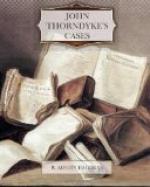Thorndyke stood up, and, having been sworn, laid on the table a small box with a leather handle. Then, in answer to the coroner’s questions, he described himself as the lecturer on Medical Jurisprudence at St. Margaret’s Hospital, and briefly explained his connection with the case. At this point the foreman of the jury interrupted to ask that his opinion might be taken on the hair and the knife, as these were matters of contention, and the objects in question were accordingly handed to him.
“Is the hair in the packet marked A in your opinion from the same person as that in the packet marked B?” the coroner asked.
“I have no doubt that they are from the same person,” was the reply.
“Will you examine this knife and tell us if the wound on the deceased might have been inflicted with it?”
Thorndyke examined the blade attentively, and then handed the knife back to the coroner.
“The wound might have been inflicted with this knife,” said he, “but I am quite sure it was not.”
“Can you give us your reasons for that very definite opinion?”
“I think,” said Thorndyke, “that it will save time if I give you the facts in a connected order.” The coroner bowed assent, and he proceeded: “I will not waste your time by reiterating facts already stated. Sergeant Bates has fully described the state of the room, and I have nothing to add on that subject. Dr. Davidson’s description of the body covers all the facts: the woman had been dead about ten hours, the wound was unquestionably homicidal, and was inflicted in the manner that he has described. Death was apparently instantaneous, and I should say that the deceased never awakened from her sleep.”
“But,” objected the coroner, “the deceased held a lock of hair in her hand.”
“That hair,” replied Thorndyke, “was not the hair of the murderer. It was placed in the hand of the corpse for an obvious purpose; and the fact that the murderer had brought it with him shows that the crime was premeditated, and that it was committed by someone who had had access to the house and was acquainted with its inmates.”
As Thorndyke made this statement, coroner, jurymen, and spectators alike gazed at him in open-mouthed amazement. There was an interval of intense silence, broken by a wild, hysteric laugh from Mrs. Goldstein, and then the coroner asked:
“How did you know that the hair in the hand of the corpse was not that of the murderer?”
“The inference was very obvious. At the first glance the peculiar and conspicuous colour of the hair struck me as suspicious. But there were three facts, each of which was in itself sufficient to prove that the hair was probably not that of the murderer.




